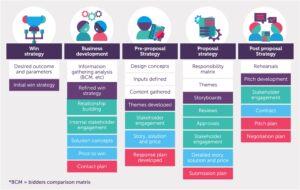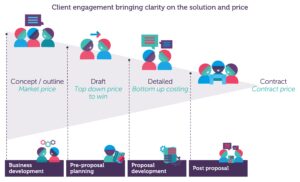Maximising success in large and complex sales cycles: a seamless path from concept to contract
This article explores common pitfalls in large and complex sales cycles and offers practical solutions to avoid them.
Three common pitfalls
- Lack of strategy and process
According to a McKinsey report, a staggering 70% of sales organisations lack a clear strategy for their sales processes. This lack of strategy can be likened to a ship embarking on a journey without a navigational chart. Without a clear strategy, sales teams may find themselves constantly reinventing the wheel, losing critical information, and misinterpreting earlier decisions. Backing this up is another statistic from McKinsey: 50% of sales leaders believe their sales planning is ineffective due to a lack of data-driven decision-making.
- Internal stakeholder engagement and resource allocation
Engaging internal stakeholders and securing the right resources at the right time is crucial for maintaining momentum in a long lead-time and complex sales cycle. Unfortunately, further McKinsey research shows that 60% of sales pursuits fail due to poor internal stakeholder engagement and coordination. Using our maritime analogy again, this is like reaching your destination only to find that the port authorities do not allow you to dock! Poor stakeholder engagement leads to another issue as summarised in the same research: 40% of sales pursuits fail because the right resources are not allocated at the right time.
- Customer engagement and understanding
Maintaining consistent communication with your customer stakeholders is essential for building trust and keeping the relationship alive. Sounds easy, but McKinsey research found that 50% of sales teams struggle with keeping consistent communication with key stakeholders.
Addressing the potential pitfalls
- Lack of strategy and a connected process
Your approach should start with winning, then work backwards to define what’s needed to achieve that. Define the characteristics of winning in terms of knowledge of the customer, strength of relationship, clarity on solution, value to the customer, competitive threats, and so on. Then work out what needs to happen by when, to get there. Once defined, as things change and become complicated, keep focused on the result to help prioritise action and make decisions. With these fundamentals in place, you’ll be able to show management what you need to win.
You then need a clear process that ensures you capture the right information, succeed in delivering the actions needed to win, and are thorough and efficient across the phases of the opportunity. Otherwise, you’ll be disjointed, and things will get missed. The diagram below shows a high-level process across the opportunity phases with clear threads of information and activity. For example, you can see how the solution evolves from concept to contract, based on information gathered early and throughout the process. More on that later.

*BCM = bidders comparison matrix
- Getting – and retaining – internal stakeholder attention
To help overcome this next challenge, we recommend:
Formalising your governance process: A well-defined gate process with clear inputs and outputs, and defined levels of authority. This will ensure that your stakeholders are identified early, know their responsibilities, and can provide decisive actions at key stages.
Incorporating effective reviews: Including stakeholders in review sessions keeps them engaged and invested. For example, we’ve seen proposal quality increase by at least 10% with effective final document reviews.
Opportunistic and creative communication: Outside of more formal interaction points, just like you’ll do with your customer, find other ways to keep internal stakeholders informed and aligned. Make your communications two-way, engaging and concise – retaining focus on your current position to win and ideas to improve.
Using your executive sponsor: Provide progress to the wider stakeholder group via your executive sponsor to align and accelerate decision-making.
Always build a comprehensive internal communication plan for each opportunity. Regular updates, meetings, and briefings will ensure full engagement and alignment, making the core team’s work easier.
- Gaining interest from the customer and building solutions for them
Engaging the customer is a significant challenge – from piquing their interest, to building mutual understanding, developing trust, and keeping momentum. Many organisations focus heavily on internal governance rather than the customer offer, spending 80% to 90% of their bidding effort internally. Clearly this is wrong, so to key alignment with customer expectations and avoid misunderstandings, regular interaction is crucial. Here are recommended strategies:
Build a stakeholder matrix: Identify all customer decision-makers, assess their drivers, position on suppliers, and decide how to connect with them. Assign team members with responsibility to lead the engagement with each customer stakeholder.
Pique their interest: Use research to understand each stakeholder and engage them through existing connections, targeted marketing, meeting at events, and public relations.
Maintain regular contact: Plan your first interaction carefully. Listen to their challenges, share success stories, and establish follow-up opportunities to build trust. Regular interactions are essential, such as:
- Regular check-ins: Schedule consistent touch points to discuss evolving needs and share insights.
- Tailored communications: Address specific concerns with customised interactions. Proactive proposals with clear solutions and proof points can be effective.
- Value demonstrations: Showcase your solutions through case studies, site visits, and reference calls. Present your understanding of the customer’s needs and potential approaches.
- Customer workshops: Organise collaborative sessions to share ideas and insights, fostering partnership and co-creation. Use bespoke decks, posters, and whiteboards to guide discussions.
Creating personalised solutions: Develop your solution iteratively based on ongoing interactions, influencing customer requirements before the final set is issued. This process, visualised below, ensures consistent customer engagement, helps build trust, and aligns your solution closely with their needs, enhancing your chances of success.

About the author
Graham Ablett has a proven history in driving significant business growth and winning high-stakes contracts. As an expert in bidding, Graham specialises in complex sales cycles, stakeholder engagement, and resource optimisation. His pragmatic approach and deep industry insights have consistently delivered exceptional results for clients across various sectors.
If you are looking to evaluate your organisation’s ability to secure large deals with long lead time sales cycles, reach out to him for a comprehensive assessment. Graham Ablett email: ga@strategicproposals.com
